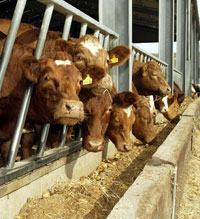EBLEX conference: The longer the chop length, the better the cudding

Don’t get too carried away with chop size for forage and maize, as cattle needed longer lengths to cud properly to offset acidosis, warned nutritionist Pete Kelly.
“Don’t get down to 0.5cm chop length, as the cow can’t cud properly,” he said. Problems with high acid loading are tackled in dairy herds by feeding small amounts (1% or 100g a head a day) of ground limestone in the ration. “Other producers can use it, but it’s not a product widely marketed, as there’s little margin in it for suppliers.
“However, trials featuring Hereford cattle have shown it can lift growth rates by as much as 20%.”
Achieving the animal’s growth rate potential was essential for economic production, he said. “A 400kg animal gaining 0.5kg a head a day is only using 27% of feed for weight gain and the rest is going on maintenance. If growth rate is 1kg, then 47% is going on weight gain.”
Avoid animals losing too much condition in any feeding or breeding cycle, he warned. “Loss of condition mobilises body fat, which can clog up an animal’s liver.
“Don’t forget the liver gets rid of hormones [in the blood] that are fat soluble. But if it can’t do that properly, a suckler cow, for example, won’t know when to ovulate.”
Too short a chop length for forage and maize reduces cud rate and increases acidosis in cattle
